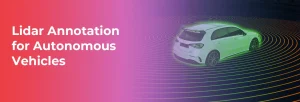Enhancing Driver-Focused Data Annotation with Image Object Annotation Services
Precise and accurate data annotation is essential to guiding the development of robust and intelligent systems in the quickly changing field of autonomous vehicle technology. More than merely a technical development, Image Object Annotation Services provide the foundation of driver-focused data annotation and are essential to teaching AI to see the world with the discernment and safety needed for safe, autonomous navigation. It is impossible to overestimate the importance of these services in recognizing and classifying visual features, such as cars, people, and traffic signs, as we dig into the complex dance of machine learning models with real-world data. Raw visual input is transformed into rich, painstakingly annotated datasets that power AI’s learning and decision-making skills through this process, primarily completed by human annotators.
In this article, we’ll talk about the critical contributions of 3D point cloud labeling and Image Object Annotation Services to developing autonomous driving technology. Both have different advantages and problems but are necessary to enhance the accuracy and dependability of driver-focused data annotation. We’ll look at how these methods work together to improve the algorithms that power autonomous cars, explore the difficulties associated with classifying data from LiDAR sources, and showcase the creative solutions advancing the field. Join us as we examine the vital role that data annotation has played in the development of autonomous cars, setting the stage for a time when robots can precisely navigate our environment.
What Is the Role of 3D Point Cloud Labeling in Driver-Focused Data Annotation?

3D Point Cloud Labeling is essential to the process as a crucial component of driver-focused data annotation. It entails labeling items inside a 3D point cloud made from LiDAR sensor data. In particular, developing autonomous driving systems depends heavily on this data for training machine learning models.
The capacity of 3D Point Cloud Labeling to offer a thorough spatial comprehension of the surroundings is a crucial benefit. It provides a 360-degree perspective that captures an object’s size, form, and depth. This degree of information is necessary to build precise and dependable machine-learning models for autonomous cars.
Using 3D Point Cloud Labeling for driver-focused data annotation has several advantages. It improves the accuracy of tracking, identification, and object detection—all vital functions of autonomous driving. Additionally, it enhances self-driving cars’ effectiveness and safety, eventually resulting in a more dependable autonomous driving experience.
Understanding 3D Point Cloud Labeling

When we examine the details of 3D Point Cloud Labeling, we find this method is crucial for data annotation, particularly for driver-focused applications.
Three-dimensional point cloud Labeling is unique because it provides a comprehensive spatial understanding of the environment. It makes a panoramic view possible, capturing things’ size, shape, and depth. This level of information is necessary to build accurate and reliable Machine Learning models, which are essential to autonomous vehicle technology.
Overview of Driver-Focused Data Annotation
- Driver-focused data annotation presents challenges in autonomous vehicle technology.
- Complexity lies in high-precision labeling of 3D point cloud data collected through LiDAR sensors.
- Crucial for practical training of Machine Learning algorithms.
- 3D Point Cloud Labeling provides comprehensive spatial understanding.
- Captures depth, shape, and size of objects.
- Essential for accurate and reliable Machine Learning models in autonomous vehicles.
- Challenges in data annotation for driver-centric applications.
- Overwhelming volume of data from LiDAR sensors.
- The labor-intensive task of assigning labels to objects in the dataset.
- Importance of precision in labeling for algorithm performance.
- Despite challenges, 3D Point Cloud Labeling is vital for autonomous vehicles.
- Detailed spatial understanding enables sophisticated ML models.
- ML models form the basis of self-driving systems.
- The solution lies in advanced annotation tools and techniques.
- Utilize Deep Learning and Machine Learning to automate annotation.
- Improve accuracy and efficiency in data annotation.
- Streamline the development of autonomous vehicle technology and drive further advancements.
Impact of 3D Point Cloud Labeling on Driver-Focused Data Annotation
Driver-aware data annotation relies heavily on 3D Point Cloud Labeling accuracy, particularly in the context of autonomous cars. This complex process requires carefully labeling data collected by LiDAR sensors, which is the basis for efficiently training Machine Learning algorithms. This task is challenging because of the data volume and the labor-intensive annotation procedure.
Notwithstanding these challenges, 3D Point Cloud Labeling is essential to autonomous car technology. It provides an unmatched spatial comprehension, registering object dimensions, shape, and depth, allowing precise Machine Learning models to be built.
Obstacles and Solutions in 3D Point Cloud Labeling for Driver-Focused Data Annotation
- 3D Point Cloud Labeling is essential for driver-focused data annotation.
- Challenges include high data volume from LiDAR sensors and meticulous labeling requirements.
- Precision in labeling is crucial for training practical Machine Learning algorithms.
- Despite challenges, 3D Point Cloud Labeling is vital for autonomous vehicle technology.
- Offers unmatched spatial comprehension, capturing object depth, shape, and size.
- Critical for developing accurate Machine Learning models.
- Advanced annotation tools powered by Deep Learning and Machine Learning are necessary.
- Automation improves accuracy and efficiency in data annotation.
- Automation of 3D Point Cloud Labeling facilitated by Deep Learning and Machine Learning.
- Provides a viable solution to challenges in driver-focused data annotation.
- Enhances accuracy and efficiency, driving advancements in autonomous vehicle technology.
Why choose Mcgence for Image Object Annotation Services?
Macgence stands apart in the rapidly emerging field of autonomous vehicle technology with its exceptional Image Object Annotation Services, which are essential for creating secure navigation systems. The combination of human experience at the core of Macgence’s methodology ensures unmatched precision in data annotation, which is crucial for developing complex machine-learning models. With a focus on the complicated and large-scale data from LiDAR sensors, Macgence handles the complex and large-scale data necessary for precise object recognition and identification. Their specialized solutions increase accuracy and efficiency by automating and improving the annotation process thanks to cutting-edge machine learning and deep learning technology. Because of Macgence’s dedication to quality and creativity in data annotation, autonomous driving technology advances more quickly, and it plays a significant role in influencing the future of transportation.
Conclusion:
In summary, data annotation accuracy and precision play a critical role in the complex realm of autonomous car technology. This paper explored the vital functions of Image Object Annotation Services and 3D Point Cloud Labeling, emphasizing their need to develop driver-focused data annotation systems. In addition to overcoming the difficulties presented by the copious and intricate data from LiDAR sensors, these approaches pave the way for the development of advanced machine learning models, which form the basis of autonomous driving technologies. This is a major advancement toward a future where cars navigate with previously unheard-of accuracy and safety.
FAQs
Ans: – By labeling visual data, they educate AI to properly perceive and navigate real-world surroundings.
Ans: – Handling enormous data quantities, maintaining accuracy, and the difficulty of identifying real-world scenarios are among the challenges.
Ans: – via developments in deep learning and machine learning for automation, as well as the creation of more advanced annotation tools.
You Might Like
October 11, 2025
Why Your AI Can’t Understand Humans: The Multimodal Conversations Datasets Gap
Your conversational AI is failing, and you probably don’t know why. It responds to words perfectly. The grammar checks out. The speed is impressive. But somehow, it keeps missing what users actually mean. The frustrated customers. The sarcastic feedback. The urgent requests are buried in casual language. Here’s what’s really happening: your AI is reading […]
October 10, 2025
Why Your Self-Driving Car Needs Perfect Vision: The LiDAR Annotation Story
Imagine you’re driving down a busy street. Your eyes are constantly scanning – pedestrians crossing, cars merging, cyclists weaving through traffic. Now imagine teaching a machine to do the same thing, except it doesn’t have eyes. It has lasers. And those lasers need to understand what they’re “seeing.” We’ve seen many product launches that aim […]
October 9, 2025
What is Synthetic Datasets? Is it real data or fake?
Picture this: You’re building the next breakthrough AI product. Your models need millions of data points to learn. But there’s a problem. You can’t access enough real-world data due to various factors, such as compliance issues, security factors, and specific needs. Privacy regulations block you. Collection costs are sky-high. And even when you get data, […]




